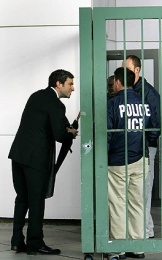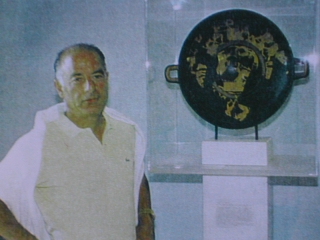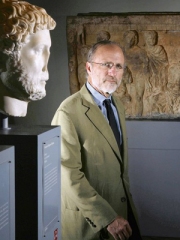 It is no coincidence that The Great Giveback, Hugh Eakin’s lengthy argument against the repatriation of looted antiquities, landed in The New York Times on Sunday, just as the directors of America’s leading art museums gathered in Kansas City for their annual meeting.
It is no coincidence that The Great Giveback, Hugh Eakin’s lengthy argument against the repatriation of looted antiquities, landed in The New York Times on Sunday, just as the directors of America’s leading art museums gathered in Kansas City for their annual meeting.
A key item on the agenda in Kansas City that day was the museum community’s handling of looted antiquities, an issue that has roiled the art world for more than a decade. The Assoc. of Art Museum Directors (AAMD) has repeatedly tried to put the issue to rest, adopting policy changes in 2001, in 2004 and again in 2006 as the controversy metastasized into a full bore international scandal. In 2008 the AAMD revisited the issue yet again, adopting acquisition guidelines that required a clear ownership history dating back to 1970, a position that put them in line with most archaeologists.
The 2008 policy was heralded as a turning point for the American museums and a victory for reformers like the Getty’s Michael Brand and Max Anderson, now in Dallas, who felt it was time for American museums to sever their ties to the black market. But those reforms are under attack. Museum directors are seeking to reverse the policy, which drives a wedge between them and wealthy patrons whose antiquities collections can no longer be donated in exchange for tax write-offs. These dissidents have made ample use of the policy’s major loophole, which allowed museums to violate the 1970 rule if they posted the acquisitions on the group’s Object Registry with a justification of why.

As Lee Rosenbaum recently noted, sixteen museums have posted nearly 600 objects there, many with no clear justification for flouting the 1970 rule. The Virginia Museum of Fine Art, for example, acquired an unprovenanced collection of 31 pieces of ancient gold jewelry, saying it violated the 1970 rule so the objects could be “studied, displayed and publicized.” Last August, the Cleveland Museum posted a Roman portrait bust of Drusus (right) that has no documented ownership history prior to 2004 and was sold to the museum by the Aboutaam brothers, antiquities dealers who have been convicted of charges related to trafficking in looted art. “Museums should still be buying antiquities, and we shouldn’t shirk that responsibility, and I think it’s almost an ethical responsibility,” Cleveland museum director David Franklin told the New York Times. (Readers of Chasing Aphrodite will recognize the quote as a nearly verbatim echo of what the Getty’s John Walsh said in 1987 to justify the acquisition of the looted statue of Aphrodite.)
In short, the Object Registry has become a tool for laundering suspect antiquities. Once objects are posted there, museum officials believe, the statute of limitations clock starts ticking, giving foreign governments just a few years to investigate, build a case and file a claim before their time expires and the objects emerge sparkling and clean. More broadly, the series of reforms taken by many American museums in recent years — which include taking claims seriously and sending looted antiquities back to the countries from which they were stolen — are under attack from within.
That brewing fight is the context for Eakin’s polemic, which notably takes aim not at source countries so much as museums like the Getty and Dallas that have embraced reforms and begun to proactively search their collections for problematic objects. With Philippe de Montebello retired and Jim Cuno forced to moderate his view by the Getty board, Eakin has emerged as the spokesman for the dissidents.
Recent events have only raised the stakes, for the controversy over looted antiquities shows no signs of going away. The depth of the problem with American collections of Classical antiquities is just beginning to emerge, with more revelations certain to come as researchers comb through the seized archives of the illicit trade’s most prominent middlemen. Meanwhile, over the past year the search for loot in American collections has gone global, with countries like Cambodia, India and Turkey bringing claims. Museum directors know better than anyone that these claims are the tip of a very large iceberg.
To the ears of some in the art world, that sound is the creaking of the floodgates swinging open.
Spurious Claims
Eakin’s piece, then, is best understood as part of a broader effort to convince the public that claims involving looted antiquities are baseless and those who cave in to them, cowards. The reforms have not only failed to stop looting (a “scourge” often given lip service by museums, but never more.) They have “spurred a raft of extravagant new claims against museums — backed by menacing legal threats.” Unless American museums grow a backbone and fight these foreign claims to the death in court, Eakin suggests, someday soon they will be empty of ancient art.
As he has done in the past, Eakin relies on a mosaic of selective facts and careful omissions to cobble together his argument. Many of its most serious flaws have already been rebutted. Lee Rosenbaum — who herself is often skeptical of repatriation claims — denounced it as a “distorted, often mistaken opinion piece” and concluded Eakin was “an extremist on the anti-giveback side.” Archaeologist Paul Barford was less kind, saying the piece “illustrates quite clearly the robber baron attitude of entitlement, hypocrisy, xenophobia and supremecism when it comes to appropriating for their own uses other peoples’ cultural property, that internationally is losing America friends.” Cultural property lawyer Rick St. Hilaire noted that Eakin’s argument “overlooks the general principle that stolen property cannot be owned lawfully or that contraband antiquities (smuggled antiquities) are somehow legitimate.” Speaking in Eakin’s favor, I could only find three voices: Peter Tompa, the lobbyist for collecting interests; blogger Judith Dobrzynski, who calls the piece “pitch-perfect” but acknowledged a conflict of interest in the subject; and LA Times art critic Christopher Knight, who celebrated the piece’s “nuance” in a tweet.

Let me focus on something I think Eakin gets almost right — his summary of recent events. (See below for his major omission.) Other archaeologically rich nations have been inspired by Italy’s success. In bringing their own claims, many have been less disciplined than Italy, which supported its demands with evidence — much of it photographic — gathered during a decade-long criminal investigation. But here Eakin misses an opportunity to articulate the key flaw of some recent repatriation requests — the conflation of historical gripes with the modern criminal behavior of looting, smuggling and fencing. For example, most of the objects Turkey is demanding from American museums were acquired since the 1960s and have no documented ownership history before that, suggesting they are likely the product of illicit excavations. Whether Turkey has evidence to support those claims remains to be seen — unlike Italy, the Turks are making their case to museums before sharing it with the public. But Turkey has also asked several European museums to return objects that were removed nearly a century ago, sometimes by archaeologists operating with government permission. And to increase their leverage, Turkey has denied digging permits to foreign archaeologists who played no role in the alleged wrongdoing. All of this — coupled with Turkey’s own history of plunder — has led to a skeptical reception of claims against American museums that may or may not be backed by clear evidence. And with good reason.
Likewise, Greece and Egypt have frequently included colonial-era claims with requests for the return of recently looted antiquities. Some of those historical claims may carry ethical weight, such as the reunification of the Parthenon marbles. But more often they blur the moral and legal clarity of claims involving modern looting. The same can be said for occasional statements that all things made in Country X should be returned to County X, which discredit the nations that make them.
So, there is legitimate reason for skepticism of repatriation claims. But these are not the arguments Eakin chose to make. Instead, he invents a picture of “terrified” museums being cowed by powerful foreign governments into giving back America’s innocently-acquired art. This description of the situation makes for an almost laughable reversal of reality.

American museums have long had the power when it comes to claims of restitution — the power to ignore claims, to withhold information and to create or defend false ownership histories. For decades, they have wielded this power freely, dismissing polite requests from foreign countries while continuing to buy looted art with impunity. For years, the Getty blew off Italian objections to their acquisitions of obviously looted art by simply refusing to respond to inquiries from senior government officials. The Met refused to allow scholars to look at its collection of looted Greek silver. Turkey has requested the return of the Sion Treasure from Harvard since the 1960s to no avail, while the university published a book about the treasure that detailed its illegal excavation and included a photo of the looter’s hole from which it was taken. Yet Eakin laments that today, 40 years later, Turkey has decided to begin withholding loans from Harvard until it responds. These are what he calls “blatantly extortionary demands.”
What motivates repatriation claims from source countries is not a desire for a few more pieces of ancient art. The basements of their museums overflow with the stuff. What they want is respect.
Let’s consider Eakin’s innocent acquisitions. If there has been a lesson from the last decade of controversy — and if there is one point made clearly in Chasing Aphrodite — it is that American museum officials were far from innocents. In case after case where internal museum records have come to light — via lawsuits or leaks to reporters — there is clear evidence that museums officials were aware they were buying recently looted antiquities. Met officials knew the Lydian Hoarde was looted and sought to hide it, as Turkey learned during its six year legal battle for their return. Dietrich von Bothmer kept a map of the precise tomb in Cerveteri from which the Euphronios krater had been looted, as we learned from Marion True’s sworn deposition. The Boston MFA’s longtime antiquities curator Cornelius Vermeule was close personal friends with Robert Hecht and acquired hundreds of looted objects from him, as the Italian investigation and Hecht’s own journal revealed.
The Getty case, our most revealing window into a museum’s antiquities acquisition process, is startlingly clear: “We know it’s stolen,” Harold Williams said in a confidential 1987 meeting about the acquisition of suspect antiquities. “Are we willing to buy stolen property for some higher aim?” Marion True discussed the contents of looted tombs in correspondence with Giacamo Medici, and declared the golden funerary wreath “too dangerous” before greed got the better of her. Her predecessor Arthur Houghton visited Medici’s Swiss warehouse and sought his help tracing the Getty’s griffins to tombs in Southern Italy. Houghton’s predecessor Jiri Frel ran a provenance forgery workshop out of the antiquities department and acquired thousands of looted objects through a tax fraud scheme whose scope is just now becoming apparent.
In other words, the evidence amassed to date makes abundantly clear that many of our highly educated antiquities curators and museum directors were not total dupes when it came to their role in the illicit antiquities trade.
They knew.
This is Eakin’s most glaring omission and the reason why repatriation is — at times — a reasonable response to foreign claims. They are the pound of flesh that must be paid for our collective cultural sins.
What standard?
How much evidence is needed to establish that an object is the product of the illicit antiquities trade and should be returned to the country from which it was stolen? For all the debate about acquisition policies, there has been nearly no debate or policy papers on this question, which is far more pressing concern facing museums today.
Eakin reminds us repeatedly that museums have returned contested antiquities under no legal order and often with no knowledge of their precise findspots. Such statements remind me of a phone conversation I had in 2006 with the Met’s de Montebello. He told me that the Met was prepared to give up its beloved Euphronios krater if Italy could present “irrefutable proof” of the precise spot from which it had been looted. Soon after, the Met’s general counsel informed him that there was no such legal standard — not even in cases of capital murder. Montebello left it to a spokesman to call back and sheepishly clarify that under the law, the vase could be seized by US law enforcement based upon probable cause. That is the legal standard for civil forfeitures. Apparently Eakin did not get the memo.
 The cases that Eakin suggests are spurious are still being negotiated, and we don’t yet have access to the full array of evidence. But what has come to light suggests they are far from fickle. In the case of Cambodia’s claim on the Khmer statue in the Norton Simon, the precise find-spot is well-known and not disputed — the statue’s feet remain in placed today at the temple complex from which it was looted. In the two cases where claims from Turkey have been resolved — Dallas and Penn — there was compelling evidence. Penn acquired the Trojan gold in 1966 from Hecht, whose ties to Turkish looters are well documented, and scientific tests later found it was consistent with samples found in Turkey. In the case of the Orpheus mosaic, investigators found Polaroids of the mosaic in situ when it arrested the alleged looters.
The cases that Eakin suggests are spurious are still being negotiated, and we don’t yet have access to the full array of evidence. But what has come to light suggests they are far from fickle. In the case of Cambodia’s claim on the Khmer statue in the Norton Simon, the precise find-spot is well-known and not disputed — the statue’s feet remain in placed today at the temple complex from which it was looted. In the two cases where claims from Turkey have been resolved — Dallas and Penn — there was compelling evidence. Penn acquired the Trojan gold in 1966 from Hecht, whose ties to Turkish looters are well documented, and scientific tests later found it was consistent with samples found in Turkey. In the case of the Orpheus mosaic, investigators found Polaroids of the mosaic in situ when it arrested the alleged looters.
Eakin’s call to legal arms betrays both his ignorance of the law and of museums’ dilemma. There is a very good reason why museums have voluntarily given back nearly $1 billion in looted antiquities with no legal fight — it was in their self-interest. As cultural property attorney Rick St. Hilaire notes, taking these cases to court “is fraught with danger.”

Museums hoping to fight in court had better make sure they have no damaging internal records detailing their acquisition of looted antiquities, for those are likely to come out in discovery, as Sotheby’s recent learned. They had better also be sure that no other objects in their collections have dubious origins, because their legal fight will inspire a thorough examination of their entire collection. This was the lesson learned by the Getty, which, as Eakin notes, chose to fight rather than accept the voluntary return of six clearly looted antiquities. Several years and millions of dollars in legal fees later, they ended up returning more than 40.
Eakin laments the cost to museums of dealing with repatriation claims. The cost of litigation is far far higher. This is not to mention the public relations consequences, which concern museums far more than a few pieces of ancient art. The true and lasting damage to American institutions over this past decade has not been legal fees or lost antiquities. It has been the growing public perception that they are engaged in an illegal activity that, at its heart, is a deep betrayal of their public mission. If they follow Eakin’s advice, they will double down on that betrayal.

The enlightened solution that Eakin seeks is the one being taken by the institutions he targets — rebuilding trust with the public and foreign governments by taking claims seriously, engaging in proactive research of their collections and sober evaluation of the evidence and when appropriate, returning a token of the stolen property in their collections in exchange for a collaborative relationship with a potential adversary.
As Eakin well knows, this approach is not “making great art ever less available.” It is providing museum visitors with remarkable rotating exhibits of the world’s great treasures while moving both source countries and museums toward a future where questions of ownership recede and the focus becomes cooperation and education.









